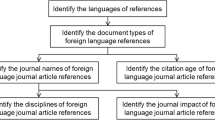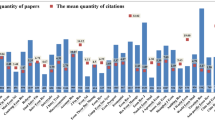Abstract
This article aims to study the other side of the coin under the background of skyrocketing of Chinese natural science papers: the anomaly phenomenon in which Chinese social science papers are getting fewer and fewer. After analysis through the cross-efficiency DEA (Data envelopment analysis) and Malmquist index, we find that: (1) Although there are fewer and fewer published papers on social science in China, the number of social science full-time teachers and PhD students in Chinese universities, the number of fund grants and grant funding from National Science Foundation of China and National Social Science Foundation of China are in increasing trends. (2) The number of gross natural science papers per capita increased while the number of gross social science papers per capita decreased. However, the number of Chinese papers per capita published in domestic journals of CSCD (Chinese science citation database)/CSSCI (Chinese social science citation index) decreased from 2009 to 2018 both in natural science and social science. (3) From 2009 to 2018, the efficiency of the publication of Chinese social science papers in every subject declined, with an average decrease of 13.5%, which is mainly caused by the regression of the production frontier. Sport Science gained the largest decrease by 45.5% while Economics gained the smallest decrease by 11.2%. After an investigation of almost all CSSCI journals, we conclude that the reason for the decline in the publication of Chinese social science papers may be that China's unique journal system could not handle the problem that the average article length increased due to the improvement of scientific research, where the increase of 19.89% in average CSSCI journal pages is much smaller than the increase of 55.10% in average paper length during 2009–2018, causing the decrease in the publication and publication efficiency of Chinese social science papers. Therefore, the academic journal system of a country may have an important impact on its scientific research outputs, and China should improve the academic journal system to promote the development of social science. Our analysis method and results can also make sence for policy makers in other countries.



Similar content being viewed by others
Notes
http://www.moe.gov.cn/srcsite/A16/moe_784/202002/t20200223_423334.html (accessed on 19 July 2020).
In China, it is customary to include humanities, philosophy, and art into social science.
References
Adetutu, M. O., & Ajayi, V. (2020). The impact of domestic and foreign R&D on agricultural productivity in sub-Saharan Africa. World Development, 125, 1–13.
Aristovnik, A. (2012). The relative efficiency of education and R&D expenditures in the new EU member states. Journal of Business Economics and Management, 13(5), 832–848.
Baker, N., & Freeland, J. (1975). Recent advances in R&D benefit measurement and project selection methods. Management Science, 21(10), 1164–1175.
Banker, R. D., Charnes, A., & Cooper, W. W. (1984). Some models for estimating technical and scale inefficiencies in data envelopment analysis. Management Science, 30(9), 1078–1092.
Charnes, A., Cooper, W., & Rhodes, E. (1978). Measuring the Efficiency of Decision Making Units. European Journal of Operational Research, 6(2), 429–444.
Chen, C. T., & Lin, M. H. (2006). Using DEA to evaluate R&D performance in the integrated semiconductor firms–Case study of Taiwan. International Journal of the Computer, the Internet and Management, 14(3), 50–59.
Chen, C. P., Hu, J. L., & Yang, C. H. (2011). An international comparison of R&D efficiency of multiple innovative outputs: The role of the national innovation system. Innovation Management Policy & Practice, 13(3), 341–360.
Chen, K., Kou, M., & Fu, X. (2018a). Evaluation of multi-period regional R&D efficiency: An application of dynamic DEA to China’s regional R&D systems. Omega, 74, 103–114.
Chen, K., Song, Y. Y., & Yang, G. L. (2018b). Quality and quantity are not always positively correlated: A case study of Chinese economics journals. Journal of Informetrics, 12(4), 1178–1181.
Chun, D., Hong, S., Chung, Y., Woo, C., & Seo, H. (2016). Influencing factors on hydrogen energy R&D projects: An ex-post performance evaluation. Renewable & Sustainable Energy Reviews, 53, 1252–1258.
Durmuşoğlu, Z. D. U. (2018). Assessment of techno-entrepreneurship projects by using analytical hierarchy process (AHP). Technology in Society, 54, 41–46.
Eilat, H., Golany, B., & Shtub, A. (2008). R&D project evaluation: An integrated DEA and balanced score card approach. Omega, 36(5), 895–912.
Färe, R., Grosskopf, S., & Norris, M. (1997). Productivity growth, technical progress, and efficiency change in industrialized countries: Reply. American Economic Review, 87(5), 1040–1043.
Guan, J., & Chen, K. (2012). Modeling the relative efficiency of national innovation systems. Research Policy, 41(1), 102–115.
Han, C., Thomas, S. R., Yang, M., Ieromonachou, P., & Zhang, H. (2017). Evaluating R&D investment efficiency in China’s high-tech industry. The Journal of High Technology Management Research, 28(1), 93–109.
Horta, H., & Shen, W. (2019). Current and future challenges of the Chinese research system. Journal of Higher Education Policy and Management, 42(2), 157–177.
Khoshnevis, P., & Teirlinck, P. (2018). Performance evaluation of R&D active firm. Socio-Economic Planning Sciences, 61, 16–28.
Lee, S., & Lee, H. (2015). Measuring and comparing the R&D performance of government research institutes: A bottom-up data envelopment analysis approach. Journal of Informetrics, 9(4), 942–953.
Lee, H.-Y., & Park, Y.-T. (2005). An international comparison of R&D efficiency: DEA approach. Asian Journal of Technology Innovation, 13(2), 207–222.
Lee, H., Park, Y., & Choi, H. (2009). Comparative evaluation of performance of national R&D programs with heterogeneous objectives: A DEA approach. European Journal of Operational Research, 196(3), 847–855.
Lee, H., Choi, H., & Seo, H. (2020). Comparative analysis of the R&D investment performance of korean local governments. Technological Forecasting and Social Change, 157, 1–10.
Leitner, K. H., Prikoszovits, J., Schaffhauser-Linzatti, M., & Wagner, S. K. (2007). The impact of size and specialisation on universities’ department performance: A DEA analysis applied to Austrian universities. Higher Education, 53(4), 517–538.
Malmquist, S. (1953). Index numbers and indifference surfaces. Trabajos De Estada, 4(2), 209–242.
Mulyanto. (2014). Performance of Indonesian R&D institutions: Influence of type of institutions and their funding source on R&D productivity. Technology in Society, 38, 148–160.
Park, J., Kim, J., & Sung, S. (2017). Performance evaluation of research and business development: A case study of korean public organizations. Sustainability, 9(12), 2297.
Rousseau, S., & Rousseau, R. (1997). Data envelopment analysis as a tool for constructing scientometric indicators. Scientometrics, 40(1), 45–56.
Rousseau, S., & Rousseau, R. (1998). The scientific wealth of European nations: Taking effectiveness into account. Scientometrics, 42(1), 75–87.
Sexton, T., Silkman, R., & Hogan, A. (1986). Data envelopment analysis: Critique and extensions. New Directions for Program Evaluation, 1986(32), 73–105.
Wang, E. C., & Huang, W. (2007). Relative efficiency of R&D activities: A cross-country study accounting for environmental factors in the DEA approach. Research Policy, 36(2), 260–273.
Xiong, X., Yang, G. L., & Guan, Z. C. (2018). Assessing R&D efficiency using a two-stage dynamic DEA model: A case study of research institutes in the Chinese academy of sciences. Journal of Informetrics, 12(3), 784–805.
Yang, G. L., Rousseau, R., Yang, L. Y., & Liu, W. B. (2014). A study on directional returns to scale. Journal of Informetrics, 8(3), 628–641.
Yang, G., Ahlgren, P., Yang, L., Rousseau, R., & Ding, J. (2016). Using multi-level frontiers in dea models to grade countries/territories. Journal of Informetrics, 10(1), 238–253.
Yang, G. L., Fukuyama, H., & Song, Y. Y. (2018). Measuring the inefficiency of Chinese research universities based on a two-stage network DEA model. Journal of Informetrics, 12(1), 10–30.
Yu, L. P. (2020). Research on the Effective Information Density Measurement of Economic Periodicals Under the Abnormal Decline of Amount of Papers. Journal of Academic Library, 38(4), 92–99. (in Chinese).
Zhao, H. (2015). The Empirical Study on R&D Efficiency of High-Tech Industry in China. International Journal of Trade, Economics and Finance, 6(1), 45–52.
Zhong, W., Yuan, W., Li, S. X., & Huang, Z. M. (2011). The performance evaluation of regional R&D investments in China: An application of DEA based on the first official China economic census data. Omega, 39(4), 447–455.
Zuo, K., & Guan, J. (2017). Measuring the R&D efficiency of regions by a parallel DEA game model. Scientometrics, 112(1), 1–20.
Acknowledgements
This work was financially supported by the Hunan Provincial Natural Science Foundation of China (Grant No. 2018JJ3298), the Ph.D. Scientific research Start-up Project of Xinjiang University (Grant No. BS202104), the Tianchi Doctoral Project of Xinjiang (Grant No. TCBS202050) and the Xinjiang High-level Talents Tianchi Program.
Author information
Authors and Affiliations
Corresponding author
Rights and permissions
About this article
Cite this article
Chen, K., Ren, Xt., Yang, Gl. et al. The other side of the coin: The declining of Chinese social science. Scientometrics 127, 127–143 (2022). https://doi.org/10.1007/s11192-021-04208-2
Received:
Accepted:
Published:
Issue Date:
DOI: https://doi.org/10.1007/s11192-021-04208-2




